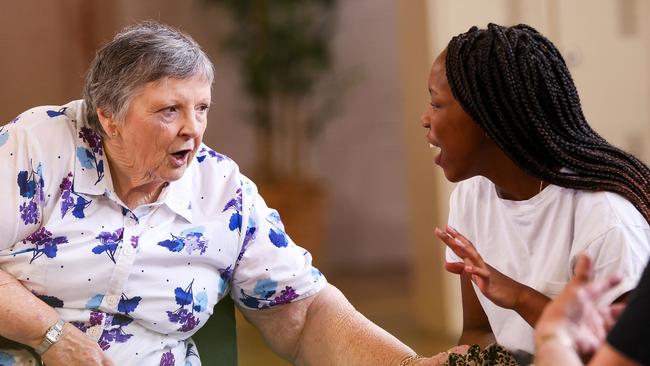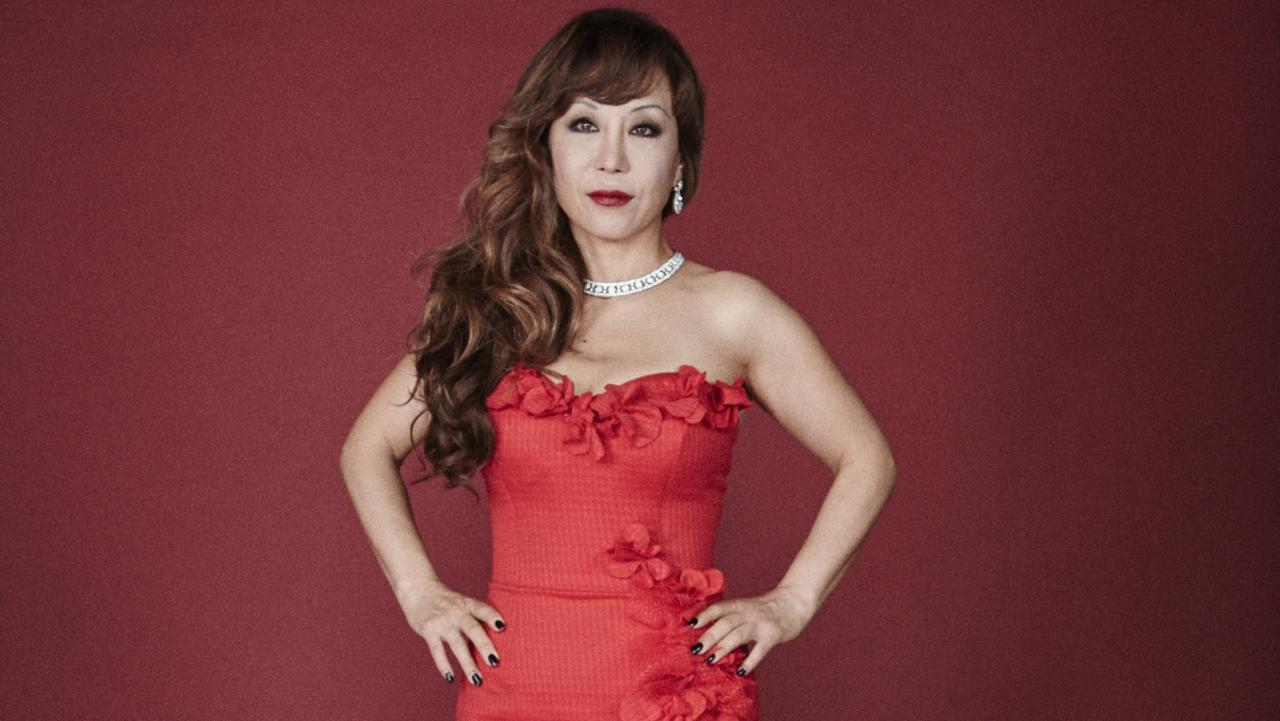Psychological drama in a retirement home? It’s irresistible
The follow up to acclaimed series Old People’s Home for Four Year Olds brings lonely teens and seniors into each other’s lives using a clever and mind-bogglingly difficult technique.

Old People’s Home for Teenagers is a new ABC documentary series and another social experiment into the dynamics of intergenerational contact. The hope is that this investigation may be used clinically and therapeutically to improve both the health and emotional disposition of elderly people living in nursing facilities and also that of vulnerable teenagers.
It’s really about the way a loneliness epidemic affects both the young and the ageing, contributing to a shared sense of social exclusion and sadness.
And what we are presented with in a highly affecting fashion is a lateral exploration of the nature of friendship, along with a clinical examination of the effects of geriatric depression, memory loss, the lack of mobility in older people, and how sedentary inactivity causes a multitude of health risks.
In particular, the show examines the emotional pain associated with feeling lonely, which can have serious consequences for long-term mental and physical wellbeing.
The series’ creators also look at the way teenagers suffer depression, anxiety about the future, trouble with maintaining stable relationships, extreme sensitivity to rejection or failure, and a lack of confidence in their day-to-day lives.
As the program shows so compellingly, young people, despite being the most connected generation when it comes to technology, are at the highest risk of loneliness. As Stephen King said, “If you liked being a teenager, there’s something wrong with you.”
The series may sound a bit ponderous in description, possibly a little earnest and solemnly educational, but it’s a clever example of the cross-fertilisation of documentary and drama, information and entertainment in factual TV.
It’s a follow-up to the highly successful Old People’s Home for Four Year Olds, where over seven weeks, two groups of 11 older Australians, men and women, living at the Anzac Village Retirement Home on Sydney’s northern beaches, were brought together with 10 preschoolers for planned, mixed activities each day in a specially designed environment built within the home.
This first critically acclaimed series won an astonishing clutch of international awards, including the 2020 International Emmy for best entertainment program, and gold at the 2020 New York TV and Film Festivals for social issues documentary. It also scooped the pool locally, picking up the 2021 AACTA for best documentary or factual program.
Old People’s Home for Teenagers is from Endemol Shine with executive producers Debbie Cuell, who developed the first series, and Tony De La Pena, two visionary veterans of factual TV. Cuell, creator of many different kinds of doco-style productions, gave us the passionate Country Town Rescue on the ABC a couple of years ago, providing a nice glimpse into a national psychology that still, if only just, prizes the bush as the home of a distinctly Australian way of life.
And De La Pena was behind the extraordinary production Keeping Australia Alive, a wrenching journey through the Australian health system, filmed in just 24 hours with the help of 100 cameras and a massive crew that stretched from one end of the continent to the other.
Old People’s Home is tied together in post-production by the narration of Annabel Crabb, who gives context to the many complex issues raised in her easygoing familiar voice.
Across six weeks the participants, who in the older age bracket range from 74 to 93 years, and in the younger range from 14 to 16 years, meet in the custom-designed Intergenerational Community Centre somewhere on Sydney’s North Shore. The older volunteers are a mix of those living at home and in assisted care. Most feel isolated, united in loneliness.
Some, like the chatty 75-year-old Phil, a retired salesperson, have given up trying to enjoy life, Phil since his battle with pancreatic cancer. Jim, a former computer engineer, is worn down by constant pain after battling shingles.
Maggy, a glamorous artist and former actor, is asked if she’s young at heart. “I used to be,” she says sadly. She lost her husband suddenly 12 months ago after he fell on a walk, leaving a vast void in her life. He used to watch Old People’s Home for Four Year Olds and she decided to do the show to honour his legacy and learn how to live and laugh once again.
The teenagers share similar stories of loneliness. Charlie, 14, is seemingly confident and gregarious but is affected by a lot of concerns teenagers face today, such as body issues and acceptance. Lily, an only child, moved to Australia from China at age nine knowing no English. Highly articulate, she spends most of her days playing music, watching anime and YouTube documentaries and being online. Louis is thoughtful and expressive in conversation but exudes sadness, his father having passed away in 2019.
I was reminded of author Paul Auster’s remark: “The best thing about being 15 is that you don’t have to be 15 for more than a year.”
The series is really a kind of makeover show, a “before and after”, as we follow a group of ordinary people through a process of change, seeing their transformation through a well-defined, if artificial, lifestyle project. The result is an original format that combines instructional programming – there are lessons here for all of us – and psychological drama.
In fact, it’s quite irresistible. I’m always fascinated by the way these kinds of complex documentary formats are brought to realisation. And by how the reality of what is being filmed needs to be altered or manipulated to provide an entertaining story, particularly in this case where so many characters are involved.
The filmmaker is unseen and events are captured as they happen, with little analysis or comment on what is unfolding. The stories are then scripted to propel them at a rate that’s appropriate for the competitive timeslot for which the program is intended.
The camera operators always seem to find some degree of invisibility. The so-called “discreet camera” can avoid unwanted attention, but it doesn’t change the fact that the subjects know the cameras are there and are aware that they are filming. The best operators work quickly to get their subjects to accept them being in their lives, though there is always the problem of the subjects believing they should be interesting enough to be on camera.
Cuell and De La Pena are masters of this craft and the air of authenticity is beguiling. Everyone involved accepts the conventions with good grace and with some humour.
And this series is a clever example of how factual programming can accommodate complexity, with many characters, situations and psychological experiments. There are clear format points which make it easy to follow the various strands, a setting or situation (often called a “precinct” in this kind of production) that delivers drama, and leading characters who go through a transformation and are hopefully in a better place at the end of the show.
What the producers do so well – and it must be mind-bogglingly difficult at times – is identify the major narrative elements that they must somehow weave together into a seamless story: strands that intertwine, comment on and echo each other in different ways. A show like this is all about coping with the jigsaw.
And answering the questions it sets itself at the outset.
Will spending time with the older adults give the teens a greater sense of resilience and confidence? Will the teenagers bring back a sense of purpose to the lives of the older people and improve their overall mental and physical health?
Crabb’s narration holds it all together: empathetic, occasionally dryly acerbic in that droll manner that’s become so characteristic of her on-air appearances, and always with a sense of shrewd evaluative acumen.
She’s the perfect fit here. She has the kind of actorly authority that producers love in their voiceover narrators, an ability to actually become part of the mise-en-scene, to speak to us as it were from within the context of the story.
Old People’s Home for Teenagers, Thursday, ABC, 8.30pm




To join the conversation, please log in. Don't have an account? Register
Join the conversation, you are commenting as Logout